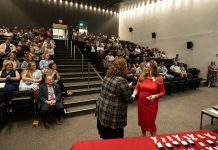As more revenue is generated to combat the opioid crisis among adults, a diminishing amount of money is going toward established programs dealing with less-threatening forms of substance abuse.
Serving as the hub in the grant-awarding process for drug abuse prevention work, the Bartholomew County Substance Abuse Council is providing 14 grants to a dozen local organizations this year.
With one grant application denied among 15 submitted, the total amount being awarded is $38,773, representing 26 percent less than what had been requested.
The denial was for a local elementary school that wanted funds to provide red ribbons for the annual Red Ribbon Week in October, which promotes drug abuse prevention. Another resource was secured to pay for that grant, said Larry Perkinson, a Substance Abuse Council member and Bartholomew Consolidated School Corp.’s employee and student assistance coordinator.
Details on this year’s grant recipients were provided in separate presentations made by Perkinson to the Bartholomew County Commissioners and the Bartholomew County Council. Both groups approved the grant funding decisions recommended by the Substance Abuse Council.
But after recalling past years when $60,000 to $70,000 in youth program grants were awarded, commissioner Larry Kleinhenz expressed surprise at this year’s lower grant amount.
Despite the overall reductions, the Substance Abuse Council did provide nearly all monies requested by two tax-supported law enforcement agencies.
The $10,073 earmarked for the Columbus Police Department and Bartholomew County Sheriff’s Department to purchase specialized equipment represents 26 percent of all grant money awarded.
Although most grants have traditionally gone toward youth substance-abuse programs, a review of past recipients shows allocations to law enforcement is nothing new for the Substance Abuse Council.
The $4,973 being given to Columbus Police Department will pay for recorders, cameras, drug-testing kits and intoxication-measuring equipment.
The $5,100 being provided to the sheriff’s department will go toward stalker radar systems used to provide probable cause to make traffic stops.
These annual grant opportunities were originally created in 1997 through the federal Drug Free Communities Support Program. However, Bartholomew County has not received federal funds for these grants in several years, and available monies have gradually shrunk, Perkinson said.
Today, grant money is generated from fees assessed by local courts, Bartholomew County Assistant Chief Probation Officer Kim Maus said. Amounts collected vary from year to year, depending on how many people are ordered to pay fees, she said.
Maus agrees with Bartholomew County Council president Mark Gorbett, who said “assessing a fee is one thing, but actually collecting it is another.”
Data suggests that programs geared toward school-age children that have received past grants have been effective, Bartholomew County Attorney Grant Tucker said.
“Our kids are making better choices,” Perkinson said, referring to social issues such as tobacco or alcohol abuse.
But historically, there are several examples where funding priorities are altered by local government in order to address more serious problems.
Evidence indicates it is mostly adults, especially between 18 and 25 years of age, that have serious heroin or methamphetamine addictions, Kleinhenz and Perkinson said.
That’s often the group of young adults who temporarily find themselves struggling with their lives after entering the work force, Kleinhenz said.
Young adults often develop a lack of self-esteem after leaving protective home and school environments, said Andrea Vogel, director of the Foundation For Youth’s Communities That Care program.
The Substance Abuse Council, along with the entire community, must establish such priorities during the opioid epidemic, Perkinson said.
“In Bartholomew County, we take it seriously,” Perkinson said.
Beside the grants, the council allocates about $200 a year for administrative expenses. Up to $5,000 is also spent annually to bring in speakers.




